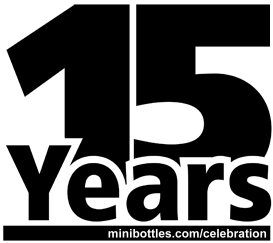The oldest whisk(e)y minibottle in my collection:
"Anderson" Pure Rye Whiskey

So today in 2024 - my oldest minibottle - the Anderson Pure Rye is 132 years old!!! |
And here are more nice older miniature bottles:
Cutty Sark Blended Scots Whisky (from 1937)
White Horse Cellar Blended Scotch Whisky (from 1940)
Anderson Pure Rye Whiskey (from 1892)
Seagram's Pedigree Straight Bourbon Whiskey (from 1927)
Macnair Fine Old Scotch Whisky (from 1937)

|
Old Smuggler Blended Scotch Whisky
Sanderson's R.O. Rare Old Blended Scotch Whisky
King George IV Blended Scotch Whisky
Chivas Regal Blended Scotch Whisky
Haig & Haig Five Star Blended Scots Whisky

|
The Seagram's Pedigree from Canada was bottled in 1919 1935!
First I thought that my Pedigree was bottled in 1919 because the blue Canadian
tax strip told me the year 1927 and the Pedigree is a 8 years old bourbon whiskey.
But Walter C. Hurst from Tucson (AZ, USA) told me the real truth (thanks, Walter):
"Canadian Tax Strips are required to bear the date of the spirits' distillation (not
bottling), indicating that your bottle was produced out of spirits first distilled
in 1927. Being of an 8-yr aged spirit, this bottle was likely produced in 1935.
Seagram Corporation is founded by Samuel Bronfman in Ville LaSalle near
Montreal, Quebec in 1924; later moved to Waterloo, Ontario in 1927, then
re-named Distillers Corporation Seagrams Limited in 1928. The front-label
bears the pre-"Distillers Corp" name, and the Waterloo, Ontario address.
Canada largely bans alcohol under various territorial bans between 1915
and 1917, by 1919 prohibition is complete throughout Canada. Your bottle
of Pedigree also bears a (red) US Federal Tax Strip, which was first used
in early 1934, shortly after the repeal of Prohibition in the US."
Again: Thanks, Walter for this great historical review and the perfect dating!

|
|
Old Whisky Liqueurs - Facts And Pictures
|
The pictures below display some old whisk(e)y liqueur minibottles.
All are from 1950 to 1960 and were sold in New York (USA).
Here are some facts about the history of these "liqueurs":
A Japanese collector's friend of mine told me that:
"at a certain period in the US, 'whisk(e)y' was prohibited by law and
many whisk(e)y brands were added with sugar or syrup and named
as 'liqueur' instead of regular whisk(e)y."
Another information I got from a distiller's company in the US is:
"in certain American states during the 1960's, coloured people were
not permitted to purchase less than a bottle of spirits. To get round
this law, sugar was added to the whisk(e)y and that 'liqueur' could
then be purchased legally by coloured people."
As you can see on the pictures below the "original" whisk(e)y labels
and the liqueur labels are nearly identical so the customer
was able to identify his prefered brand without problems.
I have the following eight old whisk(e)y liqueur minibottles in my collection
(the left bottle is the "liqueur", the right one the original whisk(e)y):
Here are the old whisk(e)y liqueur labels in detailed pictures
(the left label always displays the "liqueur" and the right one the label of the original whisk(e)y):

|
This is the
George Dickel
Tennesse Liqueur and
Sour Mash Whiskey.
These bottles are called
"Powderhorns".
They were produced
in the late 60's.
|
|
|

